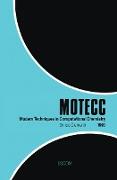Modern Techniques in Computational Chemistry: MOTECC¿-90
BücherAngebote / Angebote:
to MOTECC-90.- Global Simulations.- MOTECC: A First ¿Assembly Line¿ to Produce Chemical Information.- An Example of Global Simulation: From 3 Nuclei and 10 Electrons to a Million Molecules.- 1CAP 3090: Parallel Processing for Large Scale Scientific and Engineering Problems.- The 1CAP 3090 Experimental System.- Parallel Processing Performance Issues.- Early 1CAP Systems.- Conclusions.- References.- 2. Independent Electron Models: Hartree-Fock for Many-Electron Atoms.- The Analytic Hartree-Fock Method.- Open Shell Methods and Roothaan Vector Coupling Coefficients.- Basis Sets for Atomic Computations.- Optimization of Orbital Exponents.- Contraction Coefficients.- Geometrical Basis Sets.- Matrix Elements, Spherical Symmetry and Integrals.- The Correlation and Pair Correlation Energies.- Density Functionals for Atomic Computations.- Configuration and Momentum Expectation Values.- The Finite Element Method (FEM).- Appendix 2A: Two-Electron Integrals.- Appendix 2B: Pseudopotentials.- References.- 3. Kinetically Balanced Geometric Gaussian Basis Set Calculations for Relativistic Many-Electron Atoms.- Preliminary.- Matrix Elements of the Hamiltonian.- Choice of Basis Sets.- Relativistic Hartree-Fock-Roothaan Equation.- Angular Coefficients.- Evaluation of Matrix Elements.- Finite Nucleus Approximation.- Open-Shell Calculations.- Vector Coupling Coefficients.- Numerical Results.- Conclusions.- References.- 4. Non-Relativistic Configuration Interaction Calculations for Many-Electron Atoms: ATOMCI.- Tensor Operator.- Recoupling Transformation.- Complete Set of Shell States.- Shell Creation Tensor Operators in LS Scheme.- Complete Shell States in LSQ Scheme.- Generation of Shell States in ATOMCI.- Matrix Elements.- Orthonormal Tensors for Many Shells.- Hamiltonian Operator.- Reduction Formulas for Matrix Elements.- Appendix 4A: Simply Reducible Group.- Integer Representation and Half Integer Representation.- Even and Odd Representation.- Three-j Symbols.- Six-j Symbols and Nine-j Symbols.- Appendix 4B: Rotation Group.- References.- 5. HYCOIN: Hylleraas Configuration Interaction Method Using Gaussian Functions.- Theory.- Applications and Specific Examples.- Appendix 5A: Two-Electron Integral Formulas.- The S Integral.- The K Integral.- The N Integral.- Appendix 5B: The R(ij) Operator.- Appendix 5C: Three-Electron Integral Formulas.- The S Integral.- The T Integral.- The K Integral.- The N Integral.- Appendix 5D: Four-Electron Integral Formulas.- The S Integral.- The T Integral.- The U Integral.- Appendix 5E: Exponential Integral Formulas.- The SE Integral.- The EE Integral.- The KE Integral.- The NE Integral.- References.- 6. HONDO: A General Atomic and Molecular Electronic Structure System.- Wavefunctions and Energies.- Closed Shell Hartree-Fock (SCF) Wavefunction.- Spin Unrestricted Open Shell Hartree-Fock (UHF) Wavefunction.- High Spin Restricted Open Shell Hartree-Fock (ROHF) Wavefunction.- General Restricted Open Shell Hartree-Fock and Generalized Valence Bond (ROHF-GVB) Wavefunctions.- Configuration Interaction (CI) Wavefunction.- Multiconfiguration Hartree-Fock (MCSCF) Wavefunction.- Moller-Plesset Perturbation (MP2, MP3, MP4).- Electronic Properties.- Dipole Polarizability and Hyperpolarizabilities.- Molecular Structure Options.- Equilibrium Structure Determination.- Transition State Determination.- Force Constant Calculation.- Infrared and Raman Intensities Calculation.- Reaction Pathway Determination.- Potential Surface Scan.- Crossing Seam Minimum Energy Point Determination.- Non-Gradient Optimization.- Other Options.- Electron Transfer Reactions.- Effective Core Potentials.- Representation of An External Field.- Miscellaneous Features.- Integrals and Derivatives.- Point Group Symmetry.- Illustrative Examples.- References.- 7. KGNMOL: A Program for Large Molecules and Molecular Interactions.- Ab Initio Computation of Large Molecules.- Basis Sets: Gaussian Type Functions.- The Hydrogen Molecule and the Water Dimer.- Basis Set Superposition Error (BSSE).- Special Options for Adding Fragments or Molecules: ADD Option.- Parallelization of KGNMOL and the MP2 Option.- Density Functional for Molecules.- Clementi-Chakravorty Electron-Pair Functional.- Program Organization and Routes.- One-Electron Integral Fonnulae.- Two-Electron Integral Formulae.- General Analytical Formulae.- Special Formulas for Integrals Involving s- and p-Type Functions.- Two-Electron Integrals with Explicit Factorization of the One-Electron Dependent Terms.- Geometrical Basis Sets and Their Use.- A New Loop Structure for Uncontracted Geometrical Basis Sets.- Appendix 7A: Normalization of Gaussian Type Functions.- Appendix 7B: The Gaussian Product Theorem.- Appendix 7C: Integrals Related to the Gamma Function.- Appendix 7D: Incomplete Gamma Function.- Definition of the Incomplete Gamma Function.- Use of Taylor Series Expansions.- Asymptotic Series for the Incomplete Gamma Function.- Use of Tabular Interpolation.- Appendix 7E: The Complete Gamma Function.- References.- 8. SIRIUS: A General Purpose Direct Second Order MCSCF Program.- Why MCSCF?.- Summary of Program Features.- Theory.- Orbital Based Quantum Chemistry: The Hamiltonian.- Parameterization and Orbital Classes.- Restricted Active Space Wavefunctions.- Design of the MCSCF Wavefunction.- Restricted-step, Second-order MCSCF Optimization.- The Direct Iterative NEO Algorithm.- Implementation.- Orbital Classes, Gradient and NEO Transformation.- The Macro Iterations, Step Calculation, and Step Control.- The Micro Iterations, The Dynamical Updating of the Damping Factor, and the Direct MCSCF Step.- Integral Transformations.- Step-Control Algorithm.- Direct Configuration Interaction Theory.- RAS-CI Expansions in a CSF Basis.- Slater Determinants and Strings.- Direct CI for RAS Expansions.- Construction of Density Matrices.- Counter Rotations of CI Coefficients.- Auxiliary Optimization Algorithms.- Split Configuration and Orbital Trial Vectors.- Optimal Orbital Trial Vectors.- Convergence of Solution Vectors in Direct NEO and NR Algorithms.- Transformation to Natural and Fock Type Orbitals.- Intermediate Optimization of Orbitals for Fixed Configuration Coefficients.- Initial Guess of Orbitals and Configuration Coefficients.- Optimization of Core Hole States.- Survey of Applications.- List of General Applications.- Applications on Core Electron Spectra.- Appendix 8A: Calculation of the Orbital Part of Gradient Vectors and Sigma Vectors.- Appendix 8B: Calculation of Generalized Fock Matrices from Regular and One-Index Transformed Integrals.- Appendix 8C: The Diagonal of the Orbital Hessian Matrix.- Appendix 8D: Iterative Solution of CI Eigenvalue Problem.- References.- 9. MOLCAS: A General Purpose Quantum Chemistry Program System for Correlated Wavefunctions.- Program Descriptions.- Integral Evaluation and Handling.- The Two-Electron Transformation Program MOTRA.- The Self Consistent Field (SCF) Program.- The Restricted Active Space (RAS) SCF Program.- The RAS State Interaction (RASSI) Program.- The Configuration Interaction Programs.- Many Body Perturbation Theory (MBPT) Programs.- The Molecular Properties Program.- A Timing Example, The Pyrimidine Molecule.- Concluding Remarks.- References.- 10. MELD: A Many Electron Description.- Integrals.- One-Electron Integrals, Closed Form.- Other One-Electron Integrals.- Two-Electron Integrals.- Auxiliary Functions.- Charge Distributions.- Pseudo Potentials.- Symmetrized Integrals.- Self Consistent Field.- Integral Transformation.- Configuration Interaction.- Eigenvalue Program.- Molecular Properties.- References.- 11. ALCHEMY II: A Research Tool for Molecular Electronic Structure and Interactions.- ALCHEMY II Program Modules.- Weak Molecular Interactions.- The He ¿ H2O Interaction.- Approximate ICF Configuration Spaces.- Appendix 11A: The MOLECULE Integral Generator.- Appendix 11B: Algorithm for Large Scale Second.- Order MCSCF Calculations.- Overview of the MCSCF Method.- Second Order MCSCF Equation.- Orbital Gradient.- CI Gradient.- Orbital Hessian.- CI-Orbital Coupling.- CI Hessian.- Large CI Expansions.- Matrix Formulation of Orbital Hessians.- Orbital Hessian.- Integral Transformation.- Iterative Solution of MCSCF Equations.- Iterative Solution of a System of Linear Equations.- Convergence Threshold.- The CI Portion of VX.- The Prototype CI Method.- Overview.- Prototype Configurations.- Prototype Matrices.- Prototype Diagonal Matrices.- Prototype Singles Matrices.- Prototype Doubles Matrices.- Discussion.- References.- 12. Continuum by L2 Methods: Molecular Photoionization Cross Section.- Molecular States in the Electronic Continuum.- The K-Matrix Technique.- The Partial Wave Channels.- The L2 Basis Set Approximation.- RPA Matrix Elements in the Continuum.- One- and Two-Photons Transition Matrix Elements.- One-Photon Transitions.- Two-Photon Transitions.- Integral Cross Section by L2 Methods.- Stieltjes Imaging.- Generalization of the Stieltjes Imaging.- Computational Aspects.- The Basis Set.- One-Photon Ionization.- Two-Photon Ionization.- Appendix 12A: Rotationally Averaged Differential Cross Sections.- References.- 13. Dirac-Fock Self-Consistent Field Calculations for Closed Shell Molecules with Kinetic Balance and Finite Nuclear Size.- Preliminary.- Choice of Basis Spinors.- Evaluation of One-Electron and Two-Electron Matrix Elements.- Evaluation of Small-Component Matrix Elements.- Evaluation of Primitive Integrals in Cartesian Form.- Concluding Remarks.- Appendix 13A: Finite Nuclear Size Corrections.- Appendix 13B: Eulerian Angles and Rotation Matrix Elements.- References.- 14. First Principles Molecular Dynamics.- The Interatomic Potential Within DF Theory.- A Dynamical Approach to Energy Functional Minimization.- Molecular Dynamics in the Coupled Electron-Ion Parameter Space.- Conclusions.- References.- 15. LCAO Ab Initio Band Structure Calculations for Polymers.- The Periodic Model of a Polymer Chain.- Principles of LCAO Band Structure Calculations on Polymers.- The Electrostatic Balance Between the Nucleus- and Electron-Electron Interactions.- Multipole Expansion for Long-Range Coulomb Interactions.- The Short- or Long-Rangeness Character of the Exchange Contribution.- Use of Screw Symmetry in Polymer Calculations.- A Simulated Ab Initio Technique: The Valence Effective Hamiltonian (VEH).- Particular Aspects of Computer Implementation.- Band Structure Calculations.- Summation Over Polymeric States and Integrations Over First Brillouin Zones.- Basis Set Linear Dependence.- Band Indexing Difficulty.- Density of States Calculations.- Graphics Interface: BandDos.- Applications.- Appendix 15 A: Tables of VEH Parameters.- Single-Zeta Potentials.- Double-Zeta Potentials.- References.- 16. BNDPKG2: A Linear Combination of Gaussian Orbitals (LCGO) Band Structure Program for Cubic Crystals With One Atom Per Unit Cell.- The LCGO Method for Energy Band Calculations.- BNDPKG 2.- Sample BNDPKG 2 Calculations.- References.- 17. Monte Carlo and Molecular Dynamics Simulations.- Interaction Potentials.- Ab Initio Pair Potentials for DNA-Protein Interactions.- Model Molecules.- Ab Initio Calculations.- Classification of Atoms.- Analytical Form of the Pair Potentials.- Fitting Procedure.- Discussion.- The Monte Carlo Method.- The Molecular Dynamics Method.- Numerical Integration for the Equations of MotionCalculation of Properties.- Calculation of Properties.- Properties Related to Neutron Scattering Experiments.- Periodic Boundary Conditions and Long Range Forces.- Applications and Examples.- Simulation of Liquid Water with the NCC Potential.- MD Simulation With a Flexible Water-Water Potential.- BPTI Simulations in Vacuo and in Solution.- Neutron Scattering Properties.- Water Simulation in a Crystal of Myoglobin.- Local Structural and Dynamical Properties.- Appendix 17A: Free Energy Calculations.- References.- 18. Molecular Dynamics Simulations of Fluid Flows.- Computational Algorithm for a Large Scale Molecular Dynamic Simulation.- Applications and a Discussion of Results.- References.- 19. Brownian Dynamics Simulations of a Complex Fluid System.- Brownian Dynamic Simulation: Basic Concepts.- Fokker-Planck Description.- Langevin Description.- The Simulation Program ¿BROWNIAN¿: An Overview.- The Nonlinear Rheology of the Colloidal Suspension.- Discussion.- Shear Induced Phase Transition in the Colloidal Suspension.- Generalized Brownian Dynamics Techniques.- References.- 20. Cellular Automata.- Cellular Automata.- Two-Dimensional Lattice-Gas Automata.- Simulation of 2D Fluid Flows.- Three-Dimensional Lattice-Gas Automata.- References.- 21. The Equations of Fluid Flow and Their Solution by Finite Element Methods.- The Equations of Fluid Flow.- Derivation of the Navier Stokes Equations.- Reduction to Various Specific Forms.- The Finite Element Method.- The Method of Weighted Residuals.- The H-Version of the Finite Element Method.- The P-Version of the Finite Element Method.- Solution Techniques.- Direct Solution Methods.- Iterative Methods.- Overview of Preconditioning Techniques.- Multilevel Solution Method.- Computational Solution of the Navier Stokes Equations.- Parallel Implementation of the Solution Scheme.- Turbulent Flow.- Reynolds Equations.- Empirical Relations for the Reynolds Stress Tensor.- Direct Numerical Simulation of Isotropic Turbulent Flows.- Dealiasing.- Time Stepping Scheme.- Parallel Implementation of the Numerical Scheme.- Results.- References.- 22. The Equations of Elasticity and Their Solution by Finite Element Methods.- The Equations of Elasticity.- Computational Techniques for Linear Static Analysis.- Solution of Large 3-D Problems with Finite Elements.- Iterative Solution with the Congugate Gradient Method.- Rapid Operator Application.- Utility of Rapid Operator Application.- Parallel Implementation of Iterative Schemes.- References.- 23. Modeling of Atmospheric Pollutant Transport in Shorelines.- Model Development and Governing Equations.- Equations for the Mesoscale Variables.- Equations for the Synoptic Scale Variables.- Boundary Layer Parameterization.- Diffusivities in the Surface Layer.- Diffusivities in the Planetary Boundary Layer.- Numerical Methods.- Initial and Boundary Conditions.- Summertime Flow Over a Lake.- Summary and Conclusions.- References.- 24. Visualization Techniques and Windowing Interfaces: KGNGRAF, XWIB and REMOTE.- The graPHIGS Application Programming Interface.- to KGNGRAF.- The User Interface.- Display of Molecular Models.- Display of Electron Densities and Molecular Orbitals.- Creation and Manipulation of Molecules.- Superposition of Molecular Structures.- Molecule Building from Templates.- Protein Building from Templates.- Inquiry of Geometrical Parameters.- Display of Molecular Vibrations and Molecular Spectra.- Display of Molecular Energy Diagrams.- Interactive Animations.- Files Manipulation.- Towards More Realistic Images.- Ray Tracing for Molecules.- Animations of Realistic Images.- Animation Hardware.- Selection of the Recording Medium.- A Video Cassette Recorder Animation System.- The Configuration of the IBM PC-AT.- The Animation Recording Hardware.- An Animation Control Program for the PC-AT.- Windows Oriented Interfaces for Input Specification.- XWIB: An X Window Interface Builder.- Format Checking.- Dependency Handling Mechanisms.- Help Messages.- On-Line Documentation.- Other Utility Functions.- REMOTE: Remote File Transfer and Execution.- References.- 25. LCAP: Loosely Coupled Array of Processors Parallel Processing Software.- The Rationale for Parallelism.- Application Characteristics.- Configuration Characteristics.- How LCAP Simplifies Parallel Programming.- LCAP Design Philosophy.- Adapting to a Production Parallel Environment.- LCAP 3090 Design Principles.- LCAP Features for Effective Parallelism.- Features in the Precompiler.- Features with Parallel Calls.- Features with Shared Commons.- Performance Results Attained.- Conclusions.- 26. Parallel Algorithms.- General Principles.- Basic Matrix Operators.- Gram Schmidt Projection.- The Gauss Transform.- The Givens Rotation.- The Householder Transform.- Linear System Solvers.- LU Factorization.- Preconditioned Conjugate Gradient Methods.- Real Symmetric Eigenvalue Solvers.- Jacobi Diagonalization.- The Symmetric QR Algorithm.- Orthogonal Basis Set Generation.- Conclusions.- References.
Folgt in ca. 5 Arbeitstagen




